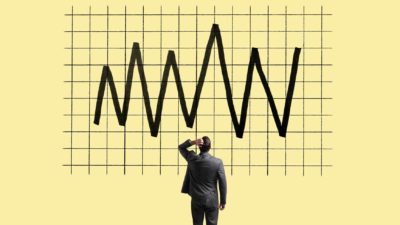You know, by the tone of my regular writing, my choice of subject – and because I tell you regularly – that I'm an optimist.
It's a view that is probably part genetic and part nurture, but it's also formed and confirmed by the arc of human history.
Sure, we have problems. And yes, I rail against some of them, too.
But overall? We have created, and continue to create, a better world.
The glaring omissions and occasional setbacks are notable precisely because they're the exceptions that prove the rule.
And, (much) more often than not, you'll read and see me extolling the virtues of the optimism and progress that has immeasurably improved human existence – and it's those same forces that drive democratic capitalism to higher heights, too.
But…
But there are those exceptions – or, at least, pockets of concern – from time to time.
Even though, as Vanguard tells us, $10,000 invested in the ASX in 1991 would have been over $160,000 thirty years later, there were periods of loss — some big and drawn out, others sharp and sudden.
Even though the economy grows, over time, there are periods of recession.
They're not welcome, but they're the things we have to live through, to get the bickies at the end.
Today, I want to (uncharacteristically) focus on one particular economic risk – something I want every reader to pay close attention to.
It's housing.
Now, I'm no housing permabear. I'm generally pretty agnostic.
I have said I expect house prices to fall as rates rise – that's Economics 101.
They may not, of course, or the falls might be pretty muted. But the maths that saw prices soar in response to falling rates should, all else being equal (and it never is, of course), see rising rates put downward pressure on prices.
But it's not house prices I'm worried about (this time, at least).
Banks aren't going to call in a loan if prices fall – doing so would set off a line of dominos as forced sellers pushed prices down, which would create more forced sellers and on and on it would go.
That would be a spectacular own-goal for the banks… which is precisely why they won't do it.
No, I think the bigger risk for homeowners — and our economy — is in something the banking regulator, APRA, said yesterday.
To be 100% clear, they didn't utter the three letters, GFC, but they invited those of us who were paying attention to make the comparison.
And that's a worry.
Let me explain.
When Australians think of the GFC, we tend to think of a recession 'over there' — we famously escaped most of the GFC pain (and a recession) thanks to prudent bank lending, a concurrent resources boom, and some well-timed and targeted government spending.
But in the US?
If you stretch your memory a little, you'll recall that the Yanks had a housing crisis, with people forced out of their homes thanks to a combination of lax lending standards, a subsequent freeze on new credit and – here's the one I want you to pay attention to – loan repayments that suddenly jumped higher.
Many of those who got themselves into trouble had taken out 'adjustable rate mortgages'. They got tiny 'honeymoon' rates from their banks for a year or two, which then 'reset' to higher rates that were simply unaffordable for many.
The good news?
On the available evidence, our banks seem to have been pretty prudent. And most Australians are ahead on their mortgages. And thankfully, 'honeymoon rates' are rare in Australia.
The bad news?
They're not called 'honeymoon rates', but Australians might be in for similar shock in a couple of years.
And it's not just me saying it.
Here's what Australian Prudential Regulation Authority chairman Wayne Byres said at an AFR Banking Conference yesterday:
"Of particular note will be residential mortgage borrowers who took advantage of very low fixed rates over the past couple of years, and may face a sizeable 'repayment shock' (possibly compounded by negative equity) when they need to refinance in the next year or two."
Does that sound familiar, based on what I just wrote?
It should.
APRA won't say 'GFC'.
But it just did. Just not in as many – well more, actually – letters.
How could it happen?
Well, as APRA just said, we have our own potential 'reset' for mortgages. Not from 'honeymoon rates', but from ultra-low fixed rates. At some future point, those people who fixed a mortgage at, say, 2% will roll over to a variable rate that might be 4% or more.
By then, those people will have become used to paying 2%. Their lifestyles will have expanded to take up the available resources.
When it 'resets' to 4% or 4.5%? When they have kids in private schools, a new car or two, and a lifestyle that they can't afford?
That's when the trouble starts.
And that's what APRA is worried about, and why I'm writing this today.
Now, to be very, very clear, I'm not making a prediction.
If we do have an Australian version of the GFC, I won't claim to have predicted it.
But I will say that I warned you it was possible.
By then, of course, it will be too late.
Some people in my position want to make grandiose predictions so they can crow about being right. It's good for their egos.
Not me. I hope I'm wrong!
I desperately hope the warning will be unnecessary. I hope we don't have our own version of the GFC.
If we do? It's going to be painful – for individuals and for the economy.
Especially on top of rising inflation, which is already eating away at financial buffers for many people.
But… there's good news.
The GFC happened precisely because people weren't prepared for it. Generals always fight the last war, because it's what they know.
This time around, we know what can happen.
We've seen the GFC. We – collectively and individually – have the tools and the willingness to do what we can to avoid it.
The regulators are already looking out for it. The policymakers at the RBA and Treasury (and in Parliament) will be aware of it.
And here's where you come in – you have time to prepare for it.
If you're on a fixed rate, congratulations – you're going to save a small fortune in the next few years.
But then, one day, you'll get a shock. Maybe a big one.
One month, you're paying perhaps 1.99%. The next? Who knows, but maybe 4% or 4.5%.
You need to do the maths. Now.
You need to adjust your lifestyle. Now.
You need to get ready. Now.
You can do this.
But you can't stick your head in the sand. That's how people get themselves into trouble.
Again, maybe it doesn't happen.
Maybe rates peak at a lower level. Or go up, then start falling again before your fixed rate expires.
Maybe.
Don't stake your financial future on it, though.
Be prepared.
Fool on!









